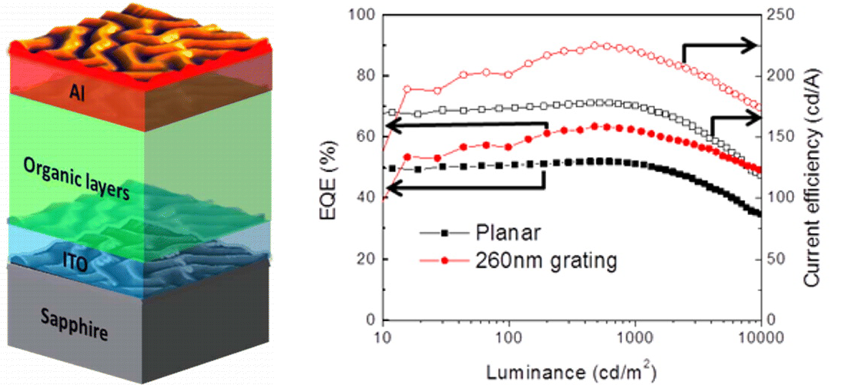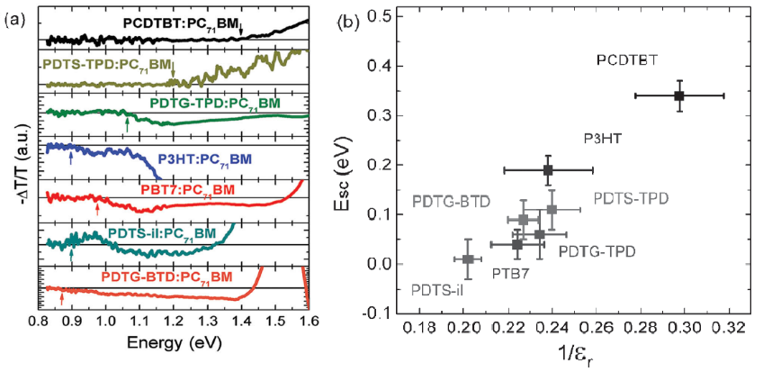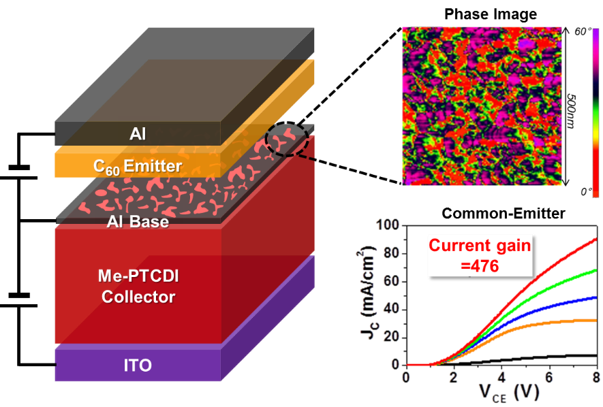Research
OLEDs:
We develop new materials, processing methods, new light extraction schemes and device structures for OLED applications. Along with the standard LED characterization techniques (L-I-V, QE, EL spectra, angular emission profiles) we also investigate the fundamental physics of OLED operation such as carrier transport and recombination as well as the mechanisms of degradation and efficiency roll-off. These studies are carried out using additional characterization techniques such as photoluminescence (PL), transient PL and transient EL.
Representative Recent Results:
In an organic light-emitting diode (OLED), only about 20–30% of the generated light can be extracted because of losses to substrate, film-guided and surface plasmon modes. Using corrugated high-index-refractive substrates, the film guided modes can be effectively out-coupled from the device and the loss to surface plasmon modes is effectively suppressed. Our research group has recently demonstrated a corrugated green phosphorescent OLED with an extremely high external quantum efficiency of 63% using a macro-lens to extract the substrate modes. (Fig 2) The light extraction enhancement is independent of wavelength and the emission profile is similar to a Lambertian emitter, demonstrating that this device is promising for OLED lighting applications.

Solar Cells:
Our group investigates the processing-structure-property relationships in emerging solution processed solar cells, especially polymer based and hybrid organic-inorganic perovskite based devices. Electrical and photophysical measurements, such as transient photovoltage (TPV), space-charge limited current (SCLC) and charge modulated electroabsorption spectroscopy (CMEAS), are used to understand fundamental material properties and how they relate to the performance of completed devices. This understanding guides our optimization of photovoltaic devices toward industrially relevant efficiencies.
Representative Recent Results:
Our group utilizes charge modulated electroabsorption spectroscopy (CMEAS) to determine the effective bandgap of polymer bulk heterojunction devices. CMEAS is a sensitive absorption technique that can directly probe sub-bandgap charge generation in completed solar cells. By examining the onset of this charge generation, we determine the effective transport bandgap of the device (Fig. 3a). The effective bandgap determined this way is better correlated to the open-circuit voltage (VOC) observed than previous measurements. Combining the CMEAS results with TPV allows for a complete understanding of the VOC observed in polymer photovoltaic devices. The difference between effective bandgap and VOC (ESC) was shown to be proportional to the inverse of the dielectric constant (Fig 3b). Therefore we were able to precisely demonstrate the relationship between dielectric constant and the observed VOC in polymer bulk heterojunction devices.

Vertical Field Effect Transistors (VFETs):
Our group is developing novel organic field-effect transistors (OFETs) and specifically focusing on high performance vertical organic field-effect transistors (VOFETs). We are investigating the switching mechanisms of these novel organic transistors based on understanding of charge transport/injection behaviors in organic materials using various electrical measurements complemented by device simulations. By demonstrating record-high performance VOFETs, our goal is to enable their commercial use as low-cost drivers for applications such as displays, sensors and memory.
Representative Recent Results:
Our group demonstrated high gain organic and inorganic/organic hybrid permeable metal-base (PMBTs). Vertical current flow in PMBTs is modulated by the potential screening effect of the permeable metal-base electrode sandwiched between two semiconductors. By controlling the pore size of a permeable metal-base at the nanoscale, we achieved record high current gain of 476. In spite of the short vertical organic channel, our PMBTs exhibited output current saturation unlike previously reported PMBTs due to a potential pinning effect at the permeable-base electrode with a small pore size of 20 nm (Fig. 4).
